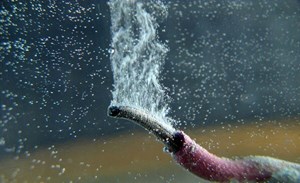News
Chung-Ang University develops chloride-resistant Ru nanocatalysts for sustainable H2 production from seawater
Growing global demand for clean energy and climate change concerns have intensified the search for sustainable alternatives. H2 emerges as a promising solution due to its high energy density and zero-carbon emissions. Among production methods, alkaline water electrolysis is efficient and environmentally friendly; however, its dependence on freshwater limits large-scale implementation. Seawater electrolysis offers a practical alternative by tapping Earth's abundant water resources, but high chloride concentrations accelerate catalyst corrosion and reduce efficiency, posing significant challenges for sustainable H2 generation.
To address this, a research team led by Assistant Professor Haeseong Jang at Chung-Ang University and Professor Xien Liu at Qingdao University of Science and Technology, developed a robust and cost-effective electrocatalyst capable of high-performance H2 evolution in saline environments. Dr. Jang shares the motivation behind this study: "Alkaline water electrolysis, though economically attractive due to inexpensive non-precious metal catalysts, faces significant challenges, including slow H2 evolution reaction (HER) kinetics and corrosion problems in real-world environments that hinder commercialization. Our research is driven by the mission to develop economically viable and stable clean H2 production technology to overcome these critical barriers." Their findings were made available online in Advanced Functional Materials on August 7, 2025.
They designed a ruthenium (Ru)-based catalyst that overcomes limitations of conventional platinum or Ru catalysts in alkaline and seawater electrolysis. They employed a g-C3N4-mediated pyrolysis strategy to synthesize nitrogen-doped carbon-supported Ru nanoclusters with a crystalline–amorphous heterostructure (a/c-Ru@NC). g-C3N4 serves as a nitrogen source and a scaffold that anchors Ru³⁺ ions through N-coordination sites. During pyrolysis, reductive gases released from g-C3N4 reduce Ru³⁺ in situ, while Ru–N bonding disrupts atomic order in the core, forming an amorphous Ru phase. Surface Ru atoms simultaneously crystallize, producing a stable crystalline–amorphous junction. This architecture ensures ultrafine Ru dispersion, electron-deficient active sites, and compressive lattice strain.
Electrochemical testing demonstrated outstanding HER performance. In 1.0 M KOH, a/c-Ru@NC exhibited an overpotential of just 15 mV at 10 mA cm⁻². Durability was confirmed with stable operation over 250 hours. Crucially, the catalyst exhibited exceptional chloride corrosion resistance with only 8 mV performance degradation and stable operation over 100 hours in simulated seawater, outperforming commercial Pt/C and Ru/C.
The study highlights several advantages. The a/c-Ru@NC synergistically combines abundant active sites with optimized electron transport. The nitrogen-doped carbon support prevents Ru oxidation and agglomeration. The overall design provides exceptional chloride-corrosion resistance. Together, these features enable cost-effective, scalable H2 production directly from seawater. This approach reduces reliance on freshwater and fossil fuels while supporting decarbonization across energy-intensive sectors.
Prof. Liu emphasized, "Our breakthrough enables seawater electrolysis for direct H2 production from seawater using chloride-resistant catalysts, opening up vast oceanic resources for clean energy generation." He added, "The enhanced alkaline water electrolysis systems demonstrate remarkable economic viability with 37-fold higher mass activity compared to commercial Pt catalysts, making H2 production significantly more cost-effective."
In conclusion, this work establishes a g-C3N4-mediated heterostructuring strategy that simultaneously addresses activity, stability, and corrosion challenges in Ru-based electrocatalysts. Dr. Jang noted, "Our technology will accelerate climate change mitigation efforts by enabling rapid decarbonization of transportation, industrial, and power generation sectors." By enabling efficient and durable seawater electrolysis, this study provides a blueprint for sustainable H2 generation from oceanic resources, paving the way for large-scale, green H2 infrastructure.


